英语人教版选修六unit2_reading说课材料
- 格式:ppt
- 大小:1.06 MB
- 文档页数:32
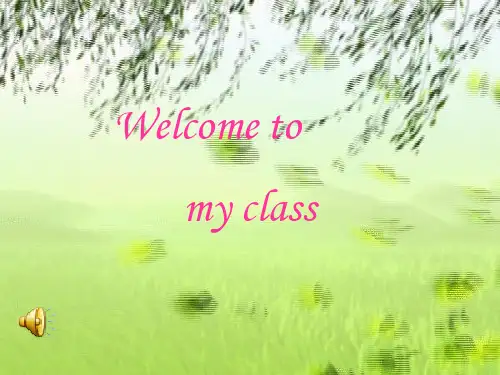
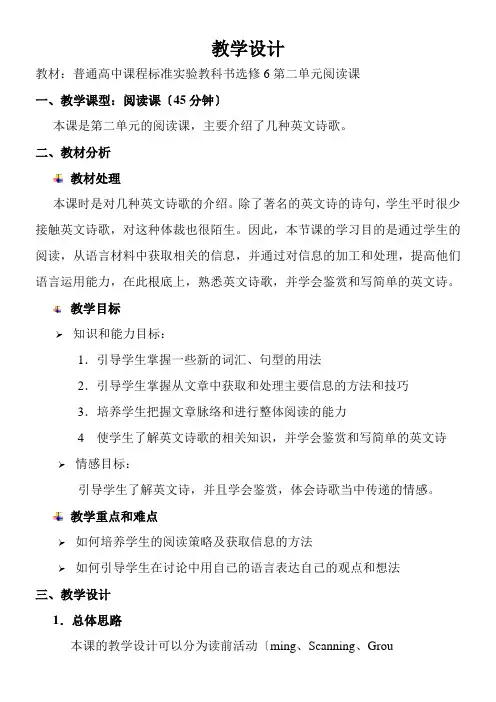
教学设计教材:普通高中课程标准实验教科书选修6第二单元阅读课一、教学课型:阅读课〔45分钟〕本课是第二单元的阅读课,主要介绍了几种英文诗歌。
二、教材分析教材处理本课时是对几种英文诗歌的介绍。
除了著名的英文诗的诗句,学生平时很少接触英文诗歌,对这种体裁也很陌生。
因此,本节课的学习目的是通过学生的阅读,从语言材料中获取相关的信息,并通过对信息的加工和处理,提高他们语言运用能力,在此根底上,熟悉英文诗歌,并学会鉴赏和写简单的英文诗。
教学目标➢知识和能力目标:1.引导学生掌握一些新的词汇、句型的用法2.引导学生掌握从文章中获取和处理主要信息的方法和技巧3.培养学生把握文章脉络和进行整体阅读的能力4 使学生了解英文诗歌的相关知识,并学会鉴赏和写简单的英文诗➢情感目标:引导学生了解英文诗,并且学会鉴赏,体会诗歌当中传递的情感。
教学重点和难点➢如何培养学生的阅读策略及获取信息的方法➢如何引导学生在讨论中用自己的语言表达自己的观点和想法三、教学设计1.总体思路本课的教学设计可以分为读前活动〔ming、Scanning、Grou2 A the tudent a quetion:What the write aboutThen ead in the toain idea of each ming the tet 〔5分钟〕e have trong rhthm and a ot of re have a fied ine ength___________i a made uaimum of word __________设计说明:学生通过这一活动,进一步理解和掌握了文章的内容,通过细读课文,要求学生带着明确的目标去阅读、查找答案,以到达有的放矢地分析课文、理解课文、解决问题的目的。
学生首先在书上查找信息,属于知识的输入阶段,然后带着问题找出答案,是知识输出的过程,真正把知识转换为能力。
Ta 3: Fi in the form 〔7分钟〕When the earthquae came, what did Timm …设计说明:让学生归纳每种英文诗的特点。
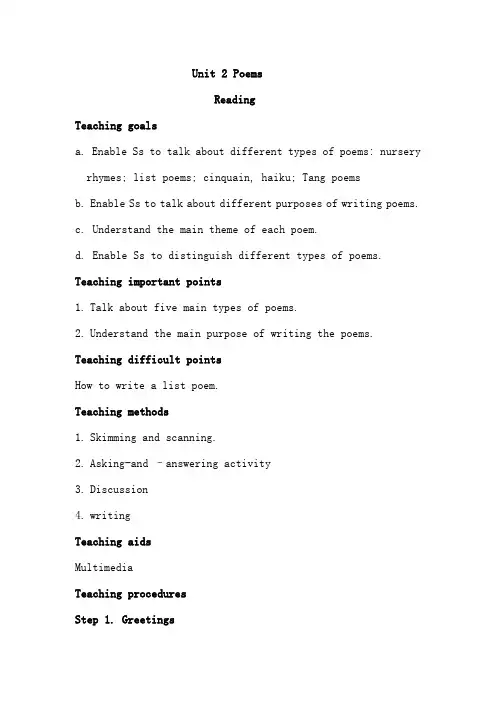
Unit 2 PoemsReadingTeaching goalsa. Enable Ss to talk about different types of poems: nursery rhymes; list poems; cinquain, haiku; Tang poemsb. Enable Ss to talk about different purposes of writing poems.c. Understand the main theme of each poem.d. Enable Ss to distinguish different types of poems. Teaching important points1.Talk about five main types of poems.2.Understand the main purpose of writing the poems. Teaching difficult pointsHow to write a list poem.Teaching methods1.Skimming and scanning.2.Asking-and –answering activity3.Discussion4.writingTeaching aidsMultimediaTeaching proceduresStep 1. GreetingsStep 2. Lead-inDo you like listening songs? I am sure that you like listening songsvery much and you like many popular singers. For example, Zhou Jielun, Wang Fei and so on. So at first, I will share a song with you. Show the song “little star” and ask the students to follow if they can sing.Brainstorming: can you predict some characteristics from the colorful words. (star, are; high, sky; gone, on; light, night.)Tell the students that this is a song and a poem as well. So the colorful words show the rhyme of a poem.Step 3.Warming upLet the Ss enjoy the English form of some pieces of famous Chinese poems and try to translate them into Chinese. Try to experience the difference between the English forms and the Chinese ones.Step 4.Reading1.fast readingAnalyze the structure of the passage and divide the passage into two parts, one part is the poems, another part is the introduction of the poems.(1)Let the Ss read just the introduction and try to answerthe question: How many kinds of the poems mentioned in the passage?(2)Read the introduction again and try to match thecharacteristics to the certain kind of the poem.2.SkimmingSkim from Poem A to Poem H and finish the flowing chart3. Careful reading:Read some of the pomes and answer the following questionsLook through poem A and choose the best answer:1.What’s the baby’s father going to buy if the mirror getsbroken?A. a mocking birdB. a diamond ringC. a looking glassD. a billy-goat2. What is Papa going to buy for the baby if that billy-goatruns away?A. a looking glassB. todayC. another billy-goatD. nothingLook through poem C and answer the following questions1. What sports do you think the speaker is writing about?2. Did his team win the game?3. How many excuses did they make to explain why they didn’t win?Read poem H and try to choose a best titleA.蝶恋花B.竹枝词C.望夫石D.一剪梅Which of the following words can convey the woman’sfeelingsA. lonelinessB. joyC. loveD. trustE. angerF. hateG. sorrowStep 5. practicingLearn to write a list poem.(1.)Analyze the characteristics of the list poem: List poems have a flexible line length and repeated phrases which give botha pattern and a rhythm to the poem. It is a poem that list things.(2.) Read poem B and poem C and try to experience the characteristics of the list poems.(3.) pair-work: give the title: “Friendship is …” and let the Ss discuss in group of four and try to write down some sentences. Divide the students into 4 groups and set a group leader for each group. And ask the group leader to collect the sentences of the poems.(4.) at last, ask the students to write down the poem of each group(5.) enjoy the works of the students together.Step 6. Homework1. Surf some websites to find out more beautiful poems.2. write a list poem.精美句子1、善思则能“从无字句处读书”。

Unit 2 PoemsPeriod 1 ——Warming up and Pre-reading Teachingmaterial: NSEFC Book6 ——Unit 2Lesson type: warmingup &speakingTeaching aids:1.ataperecorder2.aprojector3.SlidesandPicturesTeachingObjectives:1.Topresentthetopicofthisunit——poetry2.Tohelpstudentsformconceptof poetry.3.Tolearnsome wordsandusefulexpressionsinordertoexpresstheirownfeelings.4.To cultivatestudents’interest ofpoetry.TeachingImportantPoints:Howto improvethestudents’speaking ability.TeachingDifficultPoints: Howtomakethestudentsgainenoughinformationtoexpressthemselves. TeachingMethods:1.Pairworkorgroupworktomakeeverystudentjoinintheclassactivities2.Discussiontomakeeverystudentexpresshimselffreely. TeachingProcedure:Step 1: Daily Greetings(1 minute)T:Goodmorning,students!Ss:Goodmorning,MissHuang!Step 2:Warming up (11minutes)T:Lastunitwehavelearntsomethingaboutart,right?Ss: yesT:Itisakindofart.Thistimewewilllearnanotherkindofart.Whatisit?Ss:Poetry.T:Yes,poetry.Fromnowon,wewillbeginamysterioustripofpoetry——Unit4:agardenof poems.Here“poem”means诗,它是指一首具体的诗。
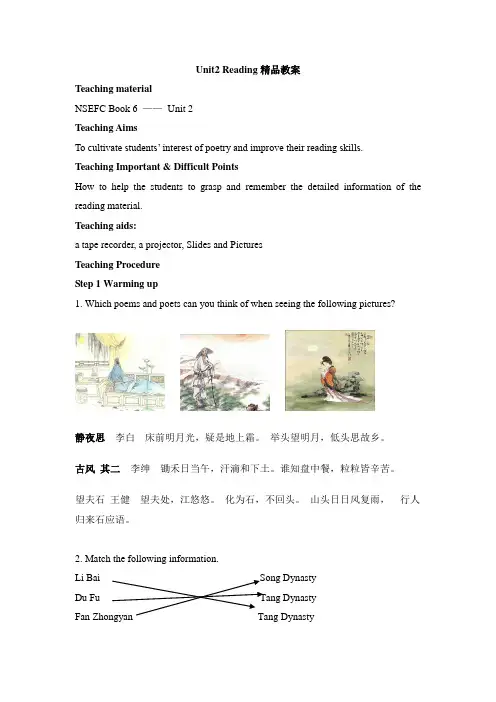
Unit2 Reading精品教案Teaching materialNSEFC Book 6 ——Unit 2Teaching AimsTo cultivate students’ interest of poetry and improve their reading skills.Teaching Important & Difficult PointsHow to help the students to grasp and remember the detailed information of the reading material.Teaching aids:a tape recorder, a projector, Slides and PicturesTeaching ProcedureStep 1 Warming up1. Which poems and poets can you think of when seeing the following pictures?静夜思李白床前明月光,疑是地上霜。
举头望明月,低头思故乡。
古风其二李绅锄禾日当午,汗滴和下土。
谁知盘中餐,粒粒皆辛苦。
望夫石王健望夫处,江悠悠。
化为石,不回头。
山头日日风复雨,行人归来石应语。
2. Match the following information.Li Bai Song DynastyDu Fu Tang DynastyFan Zhongyan Tang DynastyMeng Haoran Modern Guo Moruo Modern Mao ZedongTang Dynasty Byron America Shelly England Emerson England Tagore Germany Goethe India Step 2 BrainstormingDiscuss the reasons why people write poems. Fast readingScan the passage and answer the following questions. 1. What is the main topic of the reading passage?2. What five kinds of poems does the reading passage talk about? different forms of English poemsnursery rhymes, list poems, cinquain, haiku, Tang poems. 3. Scan the poems and fill in the following form.。
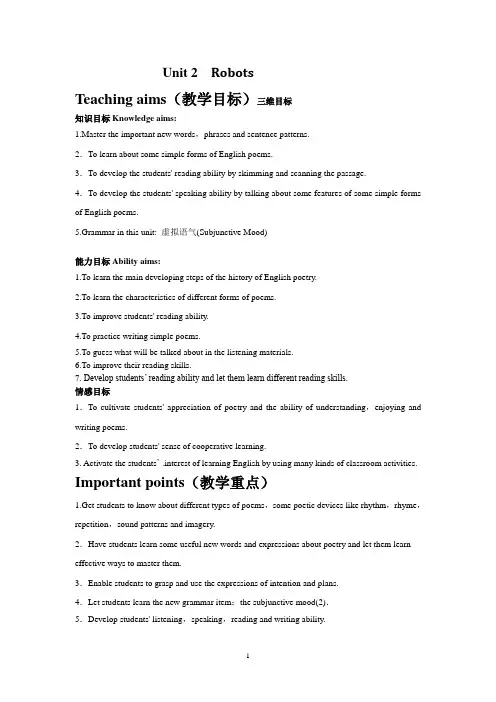
Unit 2 RobotsTeaching aims(教学目标)三维目标知识目标Knowledge aims:1.Master the important new words,phrases and sentence patterns.2.To learn about some simple forms of English poems.3.To develop the students' reading ability by skimming and scanning the passage.4.To develop the students' speaking ability by talking about some features of some simple forms of English poems.5.Grammar in this unit: 虚拟语气(Subjunctive Mood)能力目标Ability aims:1.To learn the main developing steps of the history of English poetry.2.To learn the characteristics of different forms of poems.3.To improve students' reading ability.4.To practice writing simple poems.5.To guess what will be talked about in the listening materials.6.To improve their reading skills.7. Develop students’ reading ability and let them learn different reading skills.情感目标1.To cultivate students' appreciation of poetry and the ability of understanding,enjoying and writing poems.2.To develop students' sense of cooperative learning.3. Activate the students’interest of learning English by using many kinds of classroom activities. Important points(教学重点)1.Get students to know about different types of poems,some poetic devices like rhythm,rhyme,repetition,sound patterns and imagery.2.Have students learn some useful new words and expressions about poetry and let them learn effective ways to master them.3.Enable students to grasp and use the expressions of intention and plans.4.Let students learn the new grammar item:the subjunctive mood(2).5.Develop students' listening,speaking,reading and writing ability.Difficult points(教学难点)1.Enable students to master the use of the subjunctive mood.2.Let students learn to create their own poems.3.Develop students' integrative skillsTeaching methods(教学方法)1. Task-based teaching and learning2. Cooperative learning and practice3.Asking-and-answering activity to check the students’ answers of the exercises;individual,pair or group work to finish each task.4. Fast and careful reading.5. Discussion.Teaching aids(教具)(1)a tape recorder(2)a projector(3)the blackboard、whiteboard and other normal teaching tools学法指导合作探究对话推理教材分析本单元的中心话题是诗歌。

⼈教版⾼中英语选修六Unit2《...Period 5Reading and Writing整体设计教学内容分析The teaching materials of this period contain two parts.The first part is the reading passage on Page 14 with the title of I've Saved the Summer,which is a poem telling a parent speaking to a young adult child.The older person has experiencedhis/her own journey through life and is offering love to the young person to help him/her begin on his/her own journey through life.The second part is the Writing Task on Page 54,which asks the students to write a poem.三维⽬标设计Knowledge and skills1.To enable the students to listen to the “music” of the poem,to know how it makes them feel and what it makes them think about.2.To get the students to learn the following useful new words and phrases:appropriate,exchange,sponsor,darkness,try out,let out.3.To get the students to learn the following useful structure:If I+past tense...,I would...4.To help the students learn how to write a poem starting with “If I...”.5.To foster the students' ability in skimming and looking up information in reference books and improve the students' reading ability.Process and methodsReading for specific information,summarizing,discussing and practicing.Emotion,attitude and value1.To stimulate the students' love to poetry.2.To inspire the students to write poems of their own.教学重、难点1.The understanding of the reading passage.2.The use of the subjunctive mood in poem writing.3.Teaching the students how to write a poem of their own.教学过程RevisionCheck the answers to the grammar exercises on Page 13 and explain the difficult ones.Pre-readingListen to the poem “I've saved the summer” and answer these questions:1.Do you think the speaker in the poem is more likely to be a girlfriend/boyfriend or a parent?2.Does the poem have a rhythmic pattern?3.Does the poem have rhyming words?4.When you were listening to the poem,did it make you feel something or think about something? What did it make you feel or think about?Suggested answers:1.Students' answers may vary.2.Yes(it has two strong beats per line).3.Yes.4.Students' answers may vary.Reading1.Circle the words that rhyme.What is unusual about the rhyming words in the last four lines?2.Try beating or clapping the strong beats of the rhythm as you read the poem to yourself.Now listen to the poem again and clap the strong beats.Suggested answers:1.Circled words:you,new;need,feed;nineteen,mean;way,day;own,own.The rhyming words in the last four lines are unusual because they are the same word although they each have a different meaning.2.The strong beats of the rhythm are marked below:I've saved the sum merAnd I give it all to youTo hold on winter morn ingsWhen the snow is new.I've saved some sun lightIf you should ever needA place away from dark nessWhere your mind can feed.And for myself I've kept your smileWhen you were but nine teenTill you're older you'll not knowWhat brave young smiles can mean.I know no ans wersTo help you on your wayThe ans wers lie some whereAt the bott om of the day.But if you've a need for loveI'll give you all I ownIt might help you down the roadTill you've found your own.DiscussionIn small groups discuss these questions:1.Who is the speaker in the poem and who is he/she speaking to? Give reasons to support your answer.2.Which of the following is the closest to the speaker's message? Give a reason for your choice.A.If it's cold,I'll warm you;if it's dark,I'll give you light;if you're hungry,I'll feed you;if you want love,I'll give it to you.B.Although the future may be difficult for you,whenever you need warmth and love,remember I'll have some to give you. C.While you're away I'll remember your smile and I'll love you always.When you return,I hope you will love me. Suggested answers:1.A parent(mother or father)speaking to a young adult child(son or daughter).We know that the speaker is probably a parent because he/she is offering the child unconditional love(But if you've a need for love,I'll give you all I own).We know that the son/daughter is a young adult because the speaker refers to the time when you were but nineteen.2.BLanguage studyShow the students the following language points in a slide show.1.appropriate(P13)【原句再现】Match the beginning of each sentence with the appropriate ending.把每个句⼦的开头与其合适的结尾连在⼀起。

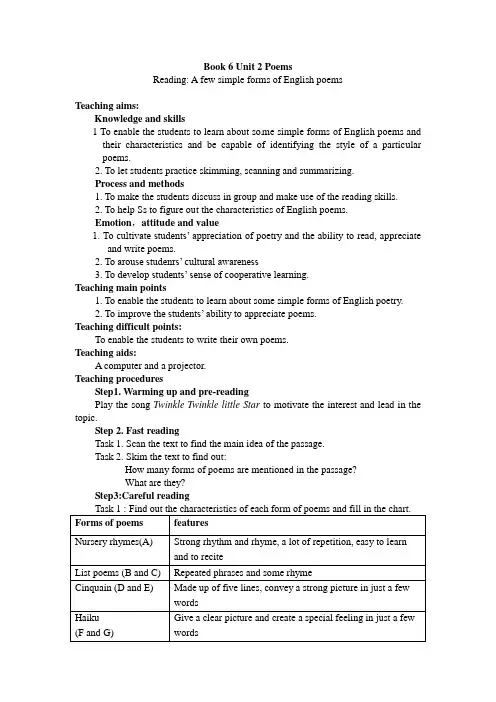
Book 6 Unit 2 PoemsReading: A few simple forms of English poemsTeaching aims:Knowledge and skills1 To enable the students to learn about so me simple forms of English poems andtheir characteristics and be capable of identifying the style of a particular poems.2. To let students practice skimming, scanning and summarizing.Process and methods1. To make the students discuss in group and make use of the reading skills.2. To help Ss to figure out the characteristics of English poems.Emotion,attitude and value1. To cultivate students’ appreciat ion of poetry and the ability to read, appreciateand write poems.2. To arouse studenrs’ cultural awareness3. To develop students’ sense of cooperative learning.Teaching main points1. To enable the students to learn about some simple forms of English poetry.2. To improv e the students’ ability to appreciate poems.Teaching difficult points:To enable the students to write their own poems.Teaching aids:A computer and a projector.Teaching proceduresStep1. Warming up and pre-readingPlay the song Twinkle Twinkle little Star to motivate the interest and lead in the topic.Step 2. Fast readingTask 1. Scan the text to find the main idea of the passage.Task 2. Skim the text to find out:How many forms of poems are mentioned in the passage?What are they?Step3:Careful readingForms of poems featuresNursery rhymes(A) Strong rhythm and rhyme, a lot of repetition, easy to learnand to reciteList poems (B and C) Repeated phrases and some rhymeCinquain (D and E) Made up of five lines, convey a strong picture in just a fewwordsHaiku (F and G) Give a clear picture and create a special feeling in just a few wordsTask 2 Read the five kinds of poems aloud and appreciate them.Step 4Post readingShow some poems to the students and let them guess which form of poem each poem belongs to.Step 5Writing1 .Let students read Poems E and D again and write their own cinquains.2.Get some students to read their poems aloud.Step 6Homework1. Surf some websites to find out more beautiful poems.2. Write a list poem.Blackboard desig nBook 6 Unit 2 Poems Reading:A few simple forms of English poems。
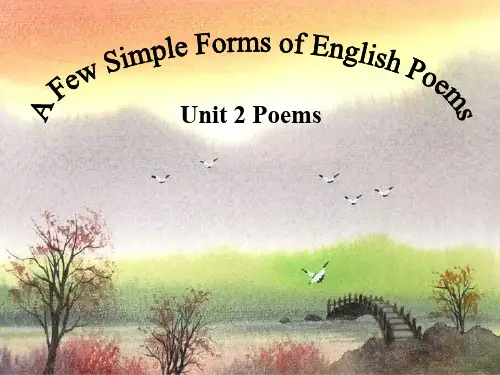

选修六Unit2 Reading –A few forms of English poems 说课稿Introduction说课提要Today I will share my idea about how to teach the reading passage A FEW FORMS OF ENGLISH POEMS taken from Unit2, Book 6, NSEFC. I am going to state my idea in 8 parts ,ie. by analy zing the teaching material, the students’ base, the teaching objectives, the teaching important points, difficult points, my teaching method, my teaching procedure, my blackboard design, and some anticipated problemsPart 1 The analysis of the teaching material说教材There are 5 units in Book 6, New Senior English for China. Each unit contains 8 sections that focus on a key topic and base the listening, speaking, reading , writing activities on the structures and functional items. The topic of this unit is poems. This lesson is to teach the reading passage A FEW FORMS OF ENGLISH POEMS taken from Unit2, Book 6, NSEFCThe passage is mainly about a few simple forms of English poems and it analyzes the characteristics of each kind of the poems while showing examples. The passage is a typical exposition, where the first paragraph leads the whole passage, stating the purpose of the poems, and in the following paragraphs are explored different kinds of poems.Part 2 The analysis of the students’ base说学情The students in senior grade 2 know a lot about the Chinese poems but they are not familiar with the English poems, even if they mostly enjoy English songs and can sing English songs. However, they will get interested in the English poems because reading the poems sounds amusing and fantasticDifferent study tasks are designed for students of different levels so as for them to learnand share the fun and attraction of English poems in the cooperative work.Part 3 The analysis of the teaching objectives说教学目标According to my analysis above and New Curriculum Standard, in this lesson ,I divide the goal into knowledge aims, ability aims, emotional aims:Knowledge aims:1. learn some simple forms of English poemsAbility aims:1. explore the characteristics of each type of poems2. interpret meaning in poetry3. identify forms of English poemsEmotional aims:1. get interested in English poems2. have a cooperative learningPart 4 The important and difficult teaching points说教学重点和难点Important points:1. characteristics of a few forms of English poems2. words and expressions in the text: take it easy, run out of time, made up of, convey, salty, endless, transformed into, etc.3. reading skills—skimming and scanning4. the ability of interpreting the meaning of some poemsDifficult points:1. Explore the characteristics of each form of poems and identify some new poems.2. Interpreting the meaning of some poems and the poetry language learningPart 5 The analysis of the teaching method说教法The task-based language teaching will be adopted. Students finish the tasks in the different cooperative interactions. They gradually learn new knowledge(the forms of English poems and the characteristics)and the new ability (to interpret and make English poems)。
Teaching material: NSEFC Book 6 —— Unit 2PoemsReadingTeaching AimsTo cultivate students’ interest of poetry and improve their reading skills.Teaching Important & Difficult PointsHow to help the students to grasp and remember the detailed information of the reading material.Teaching aids:a tape recorder, a projector, Slides and PicturesTeaching ProcedureStep 1 Warming up1. Which poems and poets can you think of when seeing the following pictures?静夜思李白床前明月光,疑是地上霜。
举头望明月,低头思故乡。
古风其二李绅锄禾日当午,汗滴和下土。
谁知盘中餐,粒粒皆辛苦。
望夫石王健望夫处,江悠悠。
化为石,不回头。
山头日日风复雨,行人归来石应语。
2. Match the following information.Li Bai Song DynastyDu Fu Tang DynastyFan Zhongyan Tang DynastyMeng Haoran ModernGuo Moruo ModernMao Zedong Tang DynastyByron AmericaShelly EnglandEmerson EnglandTagore GermanyGoethe IndiaStep 2 BrainstormingDiscuss the reasons why people write poems.Fast readingScan the passage and answer the following questions.1. What is the main topic of the reading passage?2. What five kinds of poems does the reading passage talk about? different forms of English poemsnursery rhymes, list poems, cinquain, haiku, Tang poems.Step 3 Careful readingT: Now let’s read the following five poems and finish tasks.Slide showListen to Poem A and pay attention to its rhyming lines and words. Hush, little baby, don’t say a w ord,Papa’s going to b uy you a mockingb ird.If that mockingbird won’t s ing,Papa’s going to buy you a diamond r ing.If that diamond ring turns to br ass,Papa’s going to buy you a looking gl ass.If that looking-glass gets br o ke,Papa’s going to buy you a billy-g oa t.If that billy-goat runs aw ay,Papa is going to buy you another d ay.Read the poem by yourself again and answer the following questions.1. What’ s the baby’s father going to buy if the looking-glass gets broken?2. What is Papa going to buy for the baby if that billy-goat runs away?3. What are the features of it?Keys:1. a billy -goat2. another billy-goat3. It has strong rhythm and rhyme and has a lot of repetition.Poem COur first football matchWe would have won…If Jack had just scored that goal,If we’d had just a few more minutes,If we had trained harder,If Ben had passed the ball to Joe,If we’d had thousands of fans screaming,If I hadn’t taken my eye off the ball,If we hadn’t stayed up so late the night before,If we hadn’t taken it easy,If we hadn’t run out of energy,We would have won…If we’ve been better!Questions1. Did his or her team win the game?2. Why his or her team didn’t win the game?3. Does the speaker really believe his or her own excuse? How do you know? Keys:1. No, his or her team didn’t win.2. The players didn’t win because: Jack didn’t score that goal; they didn’t have enough time; they hadn’t trained hard….3. The speaker doesn’t really believe his or her own excuses, because there has too many ifs…Poem D&E1. What subject is the speaker writing about?2. Does the speaker like the subject? Give a reason for your answer.T: We have enjoyed so many English poems. Some are traditional forms of English poetry but some are not, for example haiku. (It comes from Japanese).In fact English speaker also have borrowed from another kind of Asian poetry---Tang poems from China.Poem H at the bottom of this passage is a translation from the Chinese.Poem HWhere she awaits her husband,On and on the river flowsNever looking back,Transformed into stone.Day by day upon the mountain top,wind and rain revolve.Should the journey return,this stone would utter speech.(By Wang Jian)望夫石王健望夫处,江悠悠。
Unit2 Reading 公开课教学设计(二)人教版高中英语选修六Unit 2 Poems 教学设计朱彦涛(沙河市第一中学)ⅠAnalysis of the teaching material:The focus of this lesson is on the reading comprehension of the passage, with English poems as its main topic. By studying this lesson, students can improve their reading ability, learn some simple forms of English poems, appreciate the beauty of language used in the poems and try to create their own English poems.Ⅱ Analysis of the students:Students participating in this lesson are from Class 2, Grade 2. Class 2 is an advanced class of this grade, so English level of the students is much higher. Besides, the students are active and passionate in class. They can also cooperate well with each other and the teacher. Meanwhile, with a good understanding of Chinese poetry, they show great interest in learning English poems.Ⅲ Teaching aims:1. Knowledge aim: To learn about the characteristics of five simple forms of English poems; To develop some basic reading skills; To master some key vocabulary.2. Ability aim: To learn to find out the rhymes and rhythms of the English poetry and try to create their own English poems.3. Emotion aim: To arouse Ss’interest in appreciating English poems and English culture; Through enjoying the English poems, cultivate Ss’ love for nature and life.Ⅳ Teaching important & difficult points:To get Ss to know the simple forms of English poetry;To enable Ss to have a better understanding of poems;To guide Ss to create English poems;To improve Ss speaking and reading abilities.Ⅴ Teaching methods and aids:1. Teaching methods:Task-based teaching method; watch-listen-practice activity; question-and-answer activity; pair work or individual work method; free discussion method.2. Teaching aids:The blackboard, the multimedia, the projector.Ⅵ Teaching procedure:Step 1 GreetingsStep 2 Lead-inSince language used in poems is beautiful and inspiring, show two poems to the students to appreciate, with one of the poems an English translation of a Chinese poem---Youziyin and the other an original English poems. Through this activity, students can appreciate the poems and learn to discover some differences and similarities between Chinese poetry and English poetry. Meanwhile, guide their attention to the rhymes of the poems.The two poems are:A Song of the Travelling Son A thread in a mother's loving hand,Makes up the clothes for her travelling son. Knitting all her affection into every stitch, She's worrying he'd be away for too long. -- How could the grateful humble grass Ever repay the kindness of the generous sun?DreamsHold fast to dreams For if dreams dieLife is a broken-winged bird That cannot fly Hold fast to dreams For when dreams go Life is a barren(贫瘠的) field Frozen with snowAfterwards, get the students to recall the poems they have read, either an English poem or a Chinese one, to arouse their interest in learning poems. And ask some students to recite their poems in front of all the students.Step 3 Fast readingAsk the students to skim the passage and try to finish the following two tasks:Task 1: Find the answer to the question: How many kinds of poems are mentioned in the text? What are they?Task 2: Group work---Read the 8 poems and finish the chart with your partner by ticking the correct box(es) on P. 9The purpose of these tasks is getting the students to understand the general structure and main idea of the text and improving their reading ability, especially the skimming and scanning abilities.Step 4 Intensive ReadingRead and enjoy the following five poems and accomplish some tasks:Poem A: Listen to a nursery rhyme, and while listening, ask the students to clap out the rhythm of the poem.Hush, little baby, don’t say a word, Papa’s going to buy you a mockingbird.If that mockingbird won’t sing, Papa’s going to buy you a diamond ring.If that diamond ring turns to brass, Papa’s going to buy you a looking glass.If that looking-glass gets broke, Papa’s going to buy you a billy- goat.If that billy- goat runs away,Papa is going to buy you another today.Then answer this question: What are the characteristics of Nursery Rhymes? (Suggested answer: They rhyme, have strong rhythm, a lot of repetition, and they are easy to learn and recite.)From doing this task, students learn something about the simplest form of poem---nursery rhyme. They know poems have rhyme, rhythm, and sometimes poems are just like the song we enjoy listening. So an additional task is designed: a song --- Right Here Waiting is played. When listening to the song, students need to fill in therhyming words of the song to strengthen their knowledge of rhymes and rhythms. Poem B& C: Let the students to read Poem B together and find the rhymes in it.I saw a fish-pond all on fire,I saw a house bow to a squire,I saw a person twelve-feet high,I saw a cottage in the sky,I saw a balloon made of lead,I saw a coffin drop down dead,I saw two sparrows run a race,I saw two horses making lace,I saw a girl just like a cat,I saw a kitten wear a hat,I saw a man who saw these too,And said though strange they all were truePoem B is a list poem, which has repeated phrases that give both a pattern and rhythm of the poem. Though this poem is an amusing nonsense poem which lists some ridiculous things, it can immediately attract the students’attention and they show great interest in it.Poem D& E: Cinquain poem is a five-line poem, easy to understand and easy to write, which often convey a strong picture in just a few words. According to these characteristics of Cinquain poem, some tasks are set. First, ask the students to read poem D and E and analyze the features of this kind of poem. After the group discussion and their teamwork, the characteristics are given as follows:Line 1: a noun that names the subject of the poem;Line 2: two adjectives that describe the subject;Line 3: three verbs ending with –ing that describe the subject’s action;Line 4: four words that give the wri ter’s opinion of feelings of the subject;Line 5: a word that gives another name for the subject.Then, to satisfy the students’ desire to create their own English poems, ask them to write a cinquain by themselves, with any topic they like, and then share their poems inclass.Poem F & G: Haiku poem has clear syllables in each line, so ask the students to count the number of syllables in the lines. Every haiku has 17 syllables. By doing this, the features of the Japanese poem---haiku are exposed to the students.A fallen blossom is coming back to the branch. look, a butterfly!Poem H: this is a translation of a well-known Tang poem, telling a story of a woman who waited for her husband to return and finally transformed into stone.Where she awaits her husband,On and on the river flows Never looking back, Transformed into stone.Day by day upon the mountain top, wind and rain revolve. Should the journey return, this stone would utter speech.Students and teacher read the poem together, and taste the feelings in lines. Then discuss the main idea of the poem and what feelings of the woman can be learned from the poem.By appreciating this poem, students can know that poems can convey feelings, so inspire them to write their feelings and emotions into poems to create marvelous poems of their own.Step 5 summaryAfter enjoying the five types of poems, ask the students to summarize the features of the poems.Step 6 HomeworkLet’s appreciate more: a sheet of paper is handed out to each student with more English poems for them to read and enjoy.Ⅶ Reflection after teachingThe topic of poetry is interesting to the students, so during the whole class, the students show great enthusiasm. They take an active part in the class, cooperate well with each other and apply what they learn to create their own poems. Rather than focus on the learning of language points and the analysis of the poems, this lesson lays stress on cultivating the students’ interests in learning English and appreciating poems. However, One of defects of this lesson is that it is ended so hastily, justbecause too many contents and activities are designed without a proper arrangement of time, which has really taught me a great lesson and given me experience to better myself in the future.。